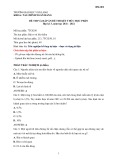
No 14 - 12.2024 - Hoa Binh University Journal of Science and Technology 5
ECONOMY AND SOCIETY
UNCERTAINTY AVOIDANCE AND DIGITAL DIVIDE AMONG SALES
AGENTS OF INTERNATIONAL INSURANCE FIRMS IN HANOI
Assoc. Prof., Dr. Thai Thanh Ha
Hoa Binh University
Corresponding Author: tthanhha@daihochoabinh.edu.vn
Received: 21/11/2024
Accepted: 15/12/2024
Published: 24/12/2024
Abstract
This research presents an exploratory investigation of sales agents of international insurance
firms in Hanoi, aiming to understand the connection between the Uncertainty Avoidance (UA), as
discussed by Hofstede (2024), and the digital divide identified by Jan van Dijk (2020). The survey
using Google Form was administered to 246 Vietnamese sales agents to collect data for SPSS
analysis. The AMOS path diagram was then employed to test the hypotheses based on the conceptual
model. The findings indicate that Uncertainty Avoidance negatively impacts the digital divide.
Additionally, five other factors - Digital Usage, Digital Accessibility, Digital Affordability, Digital
Support, and Digital Literacy - also influence the digital divide in various ways. Based on these
findings, managerial implications are provided to help bridge the digital divide among sales agents
in international insurance firms in Vietnam. Limitations and future research are also recommended
to enrich this new field of study.
Keywords: Uncertainty Avoidance, digital divide, international insurance firms, sales agents, Hanoi.
Tránh sự bất trắc và chênh lệch kỹ thuật số giữa những đại lý của các công ty bảo hiểm quốc
tế tại Hà Nội
PGS.TS Thái Thanh Hà
Trường Đại học Hòa Bình
Tác giả liên hệ: tthanhha@daihochoabinh.edu.vn
Tóm tắt
Nghiên cứu này trình bày khảo sát thăm dò các đại lý của các công ty bảo hiểm tại Hà Nội nhằm
tìm hiều mối liên hệ giữa việc tránh sự bất trắc như đã được Hofstede (2024) thảo luận và chênh
lệch kỹ thuật số theo như nghiên cứu của Jan Van Dijk (2020). Phiếu khảo sát biểu mẫu Google
Form được gửi tới 246 đại lý bảo hiểm tại Việt Nam nhằm thu thập số liệu cho phân tích trên phần
mềm SPSS. Sơ đồ tuyến trên phần mềm AMOS sau đó đã được sử dụng để kiểmt định giả thuyết
nghiên cứu được thiết lập trên cơ sở mô hình nghiên cứu. Kết quả cho thấy việc tránh sự bất trắc
đã có tác động ngược chiều với chênh lệch kỹ thuật số. Năm nhân tố còn lại bao gồm: Sử dụng số;
Tiếp cận số; Hỗ trợ số; Kỹ năng số và Khả năng chi trả kỹ thuật số cũng có tác động đến chênh lệch
kỹ thuật số theo cách riêng có. Dựa trên kết quả nghiên cứu, các hàm ý quản lý cũng đã được rút ra
nhằm thu hẹp chênh lệch kỹ thuật số giữa những đại lý của các công ty bảo hiểm quốc tế tại nước
ta. Những hạn chế và hướng nghiên cứu trong tương lai cũng đã được đề xuất nhằm làm phong phú
thêm lĩnh vực nghiên cứu còn khá mới mẻ này.
Từ khoá: Tránh sự bất trắc, chênh lệch kỹ thuật số, công ty bảo hiểm quốc tế, đại lý, Hà Nội.

6 Hoa Binh University Journal of Science and Technology - No 14 - 12.2024
ECONOMY AND SOCIETY
1. Introduction
By 2024, the concept of the digital divide
will celebrate its 29th anniversary since its
introduction in the United States. To date,
research on this topic has broadened to
encompass various fields, including as rural-
urban comparisons; ethnic minority digital
inclusion; small business digital inequality
and so on (Jan van Dijk, 2020). The insurance
industry has eyewitnessed the tendency by
which customers resort to the insurance tools,
regardless of life or non-life, to proactively deal
with the uncertainty (Fitch Solution, 2020). Yet,
this uncertainty avoidance and its linkage with
digital divide, however, have still been missing,
not to say being neglected to a certain extent,
in the pool of research in the insurance sector,
especially in the context of the international
insurance firms (The International Insurance
Society, 2024; Barroso & Laborda, 2022).
The digital transformation of the insurance
industry has fundamentally altered traditional
operational paradigms, particularly in emerging
markets like Vietnam (Eckert & Osterrieder,
2020; Theinvestor, 2024). In Hanoi's expanding
insurance sector, the integration of digital
technologies among sales agents presents a
complex landscape influenced by cultural
dimensions, notably uncertainty avoidance
(UA) from Hofstede's framework (Hofstede,
2024). Despite digital tools' demonstrated
benefits in enhancing sales processes and
operational efficiency, a significant digital
gap persists among international insurance
firms' sales agents because of the variations
in technology adoption, usage patterns,
accessibility, affordability, institutional support,
and digital competencies (Barzilai-Nahon,
2006; DiMaggio & Hargittai, 2001).
This research explores the extent to which
uncertainty avoidance (UA) relates to the digital
divide among sales agents of international
insurance firms in Hanoi, where traditional
business practices intersect with modern digital
imperatives (Abel & Marire & Papavassiliou,
2021). Shedding more light on this relationship
will contribute more to the digital divide literature
within the insurance sector while providing
actionable insights for international insurers
seeking to bridge technological gaps in such
a culturally diverse market as Vietnam (Fitch
Solution, 2020; McKinsey & Company, 2023).
2. Literature Review and Hypothesis
Development
2.1. Uncertainty Avoidance and the Digital
Divide in the International Insurance Firms
The insurance industry's digital divide
manifests through disparate access to and
adoption of digital technologies, particularly
when examined through Hofstede's cultural
dimensions (David & Bright & Anastasia
& Cortes, 2019). Uncertainty Avoidance
(UA), which reflects societal tolerance for
ambiguity, appears to significantly influence
this technological gap (Boston Consulting
Group, 2024). Research suggests that insurance
sales agents in high UA cultures demonstrate
resistance to digital tool adoption, favoring
traditional methods they perceive as more
predictable (Eckert & Osterrieder, 2020;
Eling & Lehmann, 2018). While digital
transformation requires balancing innovation
with cultural sensitivity (Vassilakopoulou &
Hustad, 2021), the relationship between UA and
digital resistance leads to our first hypothesis:
H1. Uncertainty Avoidance negatively
influences the digital divide among insurance
sales agents
2.2. Factors Constituted the Digital Divide in
the International Insurance Firms
This literature review explores five key
factors influencing the digital divide in insurance
firms: digital usage, digital accessibility, digital
affordability, society and government support,
and digital literacy. Based on these factors,
corresponding hypotheses are developed.
Digital Usage: Digital usage represents the
degree of digital technology implementation
within insurance operations. While enhanced
digital usage drives improvements in data
management and customer service (Venkatesh
et al., 2012; The economist, 2022), it
simultaneously creates performance disparities
among sales agents. Research demonstrates that
higher digital adoption correlates with improved
operational efficiency and customer satisfaction

No 14 - 12.2024 - Hoa Binh University Journal of Science and Technology 7
ECONOMY AND SOCIETY
(Jan van Dijk, 2020), yet this advancement
widens the performance gap between digitally
proficient and less-adapted agents (The
International Insurance Society, 2024). This
observation leads to our second hypothesis:
H2. Digital Usage positively influences the
digital divide among insurance sales agents.
Digital Accessibility: Digital accessibility
encompasses the ease of access to digital
technologies for insurance firms and their
agents (Jan van Dijk, 2020). Infrastructure
limitations, connectivity issues, and device
availability create significant disparities in
technological utilization (Wei & Zang, 2011).
While regions with robust digital infrastructure
demonstrate enhanced market performance
(Parasuraman & Colby, 2015), those with
limited accessibility, particularly in developing
markets, face substantial challenges in digital
tool adoption (Venkatesh et al., 2016). This
disparity in infrastructure access leads to our
third hypothesis:
H3. Digital Accessibility positively
influences the digital divide among insurance
sales agents.
Digital Affordability: Digital affordability
represents the economic capacity to access
and utilize digital technologies in insurance
operations (Asongu & Le Roux, 2017).
Research indicates that cost barriers create
significant disparities in technological adoption,
particularly affecting smaller firms (Wei &
Zhang, 2018). Studies demonstrate that firms
in high-income regions show greater digital
integration compared to those in low-income
areas (Molla & Licker, 2005; Asongu & Le
Roux, 2017), leading to varying levels of
operational efficiency among agents (Dutta and
Lanvin, 2023). This economic dimension of
digital access leads to our fourth hypothesis:
H4. Digital Affordability positively
influences the digital divide among insurance
sales agents.
Society and Government Supports: Societal
and governmental support significantly shapes
the digital landscape within the insurance sector
(Molla & Licker, 2005). Research demonstrates
that proactive digital policies and institutional
frameworks facilitate higher digital adoption
rates in financial services (Asongu & Le Roux,
2017). Studies highlight how government
initiatives addressing infrastructure, financial
support, and digital literacy correlate with
enhanced technological integration (Eling
& Lehmann, 2018; Selwyn, 2004; Chen &
Wellman, 2004), while supportive social
environments accelerate digital transformation
(McAllister et al, 2015). This institutional
influence leads to the fifth hypothesis as follows:
H5. Support from society and government
positively influences the digital divide among
insurance sales agents.
Digital Literacy: Digital literacy
encompasses the competencies needed to
effectively utilize digital technologies in
insurance operations (Jan van Dijk, 2020).
Research demonstrates that digitally literate
workforces better leverage technological tools
for service delivery (European Commission,
2022; Barzilai-Nahon, 2006), while varying
literacy levels create significant performance
disparities (Wei et al., 2011). Studies highlight
how digital literacy training enhances employee
capabilities (Barroso and Laborda, 2022) and
influences agents' adaptability to technological
changes (Parasuraman & Colby, 2015). This
variation in digital competency leads to our
sixth hypothesis:
H6. Digital Literacy positively influences
the digital divide among insurance sales agents.
3. Conceptual Model and Measurement of
Constructs
3.1. Conceptual Model
The conceptual model of this research
is developed from a synthesis of the existing
literature concerning the factors influencing
the digital divide among sales agents of the
international insurance firms actively operating
in Hanoi. Specifically, the model is composed of
six factors. They are (1) Digital Usage; (2) Digital
Accessibility; (3) Digital Affordability; (4)
Society and government supports; and (5) Digital
Literacy and finally (6) Uncertainty Avoidance
which is one of the six cultural values (Hofstede,
2024; David et al, 2019). The conceptual model
is presented in Figure 1 below.

8 Hoa Binh University Journal of Science and Technology - No 14 - 12.2024
ECONOMY AND SOCIETY
Figure 1. Conceptual Model and Hypotheses for the Research
Sources: Barzilai-Nahon (2006); Vandijk (2020) and author’s synthesis
3.2. Measurement of the Constructs
The Uncertainty Avoidance (UA) dimension
quantifies societal risk tolerance (David et al.,
2019). High UA cultures demonstrate strong
insurance product demand due to risk aversion
(Barroso & Laborda, 2022). Vietnam's UA
score of 30/100 on Hofstede's scale supports
treating UA as a continuous variable in SEM
analysis, implemented through random number
generation and analyzed via SPSS 20 and
AMOS 18. The digital divide constructs were
operationalized through validated instruments
from extant literature (ITU, 2023; Wilson &
Thomas & Barraket, 2019; Bazilai-Nahon,
2006), employing 5-point Likert scales to
measure the multifaceted factors outlined in
Table 1. In this research, there were finally 19
factor items designed to capture the nature of
the constructs and one (01) item to measure
the perceived digital divide also designed on
5-point Likert scales. This index will serve as a
dependent variable in the model.
4. Methodology
4.1. Sampling and Data Collection
This study employed a mixed-methods
approach to examine the relationship between
Sources: Author’s synthesis, 2024
Table 1. Measurement of Comprehensive Digital Divide Factors
uncertainty avoidance and the digital divide
among insurance sales agents in Hanoi (David
et al., 2019). A multi-stage sampling technique
deemed suitable to be used for sample selection

No 14 - 12.2024 - Hoa Binh University Journal of Science and Technology 9
ECONOMY AND SOCIETY
18 software. In accordance withg Hair et
al. (2019), factor analysis was employed
to identify structural relationships among
variables and create parsimonious variable sets
for subsequent analysis. All items achieved
statistical significance at the 0.001 level on the
Kolmogorov-Smirnov normality test, satisfying
the fundamental assumptions for factor analysis
(Swierczek et al., 2003).
5. Results and Discussions
5.1. Descriptive Statistics
The description of survey respondents
is presented in Table 2. It shows that female
respondents account for 49.2% while male
respondents make up 50.8%. Those who were
in the 18-25 age bracket amounted to 56.9%
while respondents who were in the age of
26-34 years accounted for 20.3%. If taken
together, the percentage of survey respondents
from 18 up to 34 years old reaches 77.2%. The
surveyed respondents who were from 35 years
old and above took the remaining percentage
of 22.8%. These age cohorts were also in line
with the general tendency in international
insurance firms in Vietnam (McKinsey &
Company, 2023).
5.2. Exploratory Factor Analysis (EFA)
The Exploratory Factor Analysis results for
the five digital divide constructs (Table 3) revealed
significant factor loadings exceeding the 0.5
threshold. Loading magnitudes informed factor
labeling decisions, with higher loadings carrying
greater definitional weight (Hair et al., 2019).
Dimension reduction yielded Cronbach's Alpha
coefficients above 0.7 for all factors, meeting
reliability thresholds for exploratory research.
The Kaiser-Meyer-Olkin (KMO) measure of
sampling adequacy reached 0.89, indicating
appropriate factorial simplicity (Swierczek et
al., 2023). These loaded items' average scores
subsequently formed composite variables for
structural equation modeling analysis.
of sales agents from two leading insurance firms
in Hanoi: Prudential Vietnam and Cathay Life
(Fitch Solution, 2020). A questionnaire, adapted
from Western literature and culturally validated,
was administered to assess participants'
uncertainty avoidance, digital literacy, usage,
and perceptions of accessibility and affordability
(Hair et al., 2019). Semi-structured interviews
were also conducted to delve deeper into the
cultural, organizational, and individual factors
influencing the digital divide (Lu & Liang,
2024). This mixed-methods approach provided
a comprehensive understanding of the complex
interplay between uncertainty avoidance and
the various determinants of the digital divide
within the insurance sales context in Hanoi
(Laura & Mihai & Mihaela, 2020).
4.2. Data Processing and Statistical Analysis
Data collection yielded 350 initial
responses via Google Sheets, with 246
complete submissions representing a 70.3%
response rate. The dataset was subjected
to preliminary processing in SPSS 20 for
missing value imputation and outlier treatment,
followed by advanced analysis using Structural
Equation Modeling (SEM) in the AMOS
Table 2. Statistical Characteristics of Survey Respondents
Sources: Synthesis from survey respondents in 2024
Criteria NPercent Criteria NPercent
Prudential Vietnam 143 58% Female 121 49.2%
Cathay Life 103 42% Male 125 50.8%
From 18-25 years old 140 56.9%
Below University 12 4.9% From 26-34 years old 50 20.3%
University 202 82.1% From 35-45 years old 34 13.8%
Post-graduate 32 13% From and above 46 years old 22 9.0%
Total 246 100% Total 246 100%


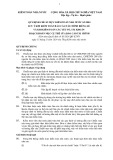

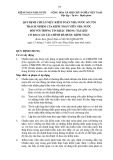
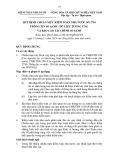
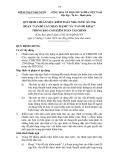



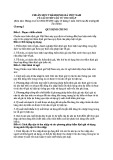
![Bài tập môn Định giá tài sản [chuẩn nhất]](https://cdn.tailieu.vn/images/document/thumbnail/2025/20250926/julianguyen2706@gmail.com/135x160/5591758870701.jpg)








![Bài giảng Bảo hiểm: Chương 2 - Nguyễn Đoàn Châu Trinh [FULL]](https://cdn.tailieu.vn/images/document/thumbnail/2025/20250414/trantrongkim2025/135x160/440_bai-giang-bao-hiem-chuong-2-nguyen-doan-chau-trinh.jpg)

